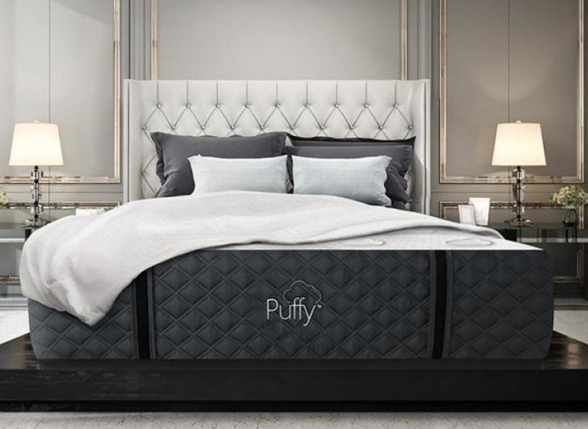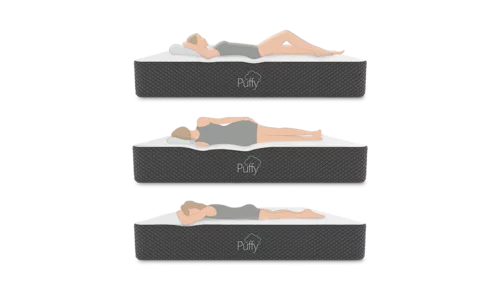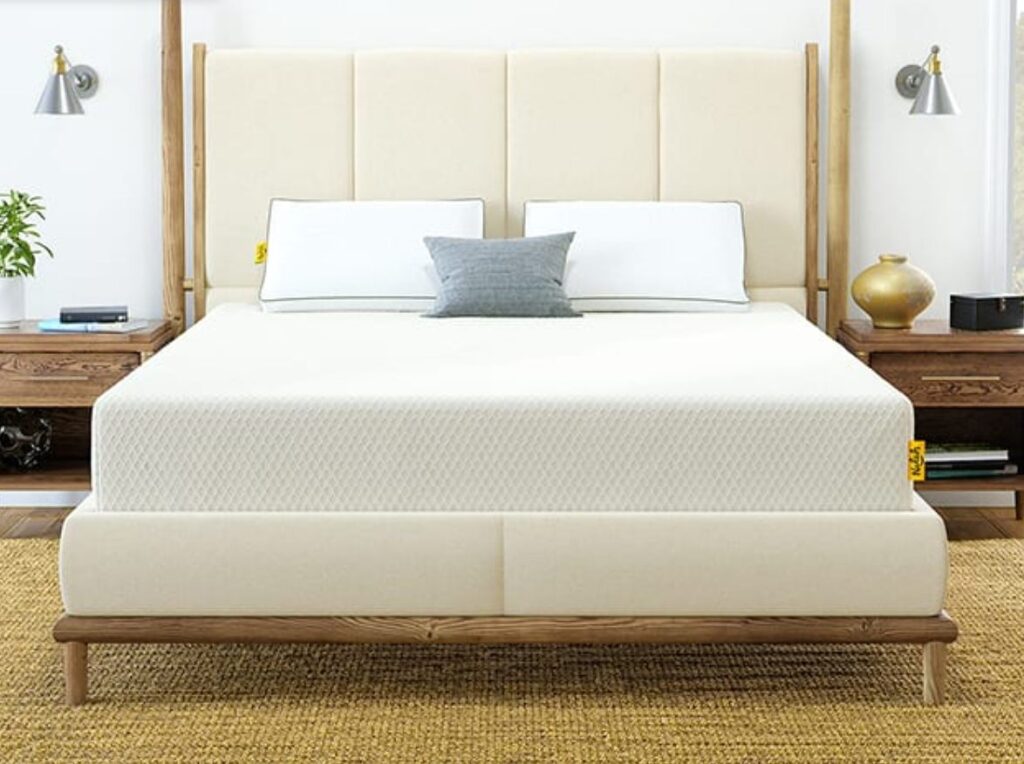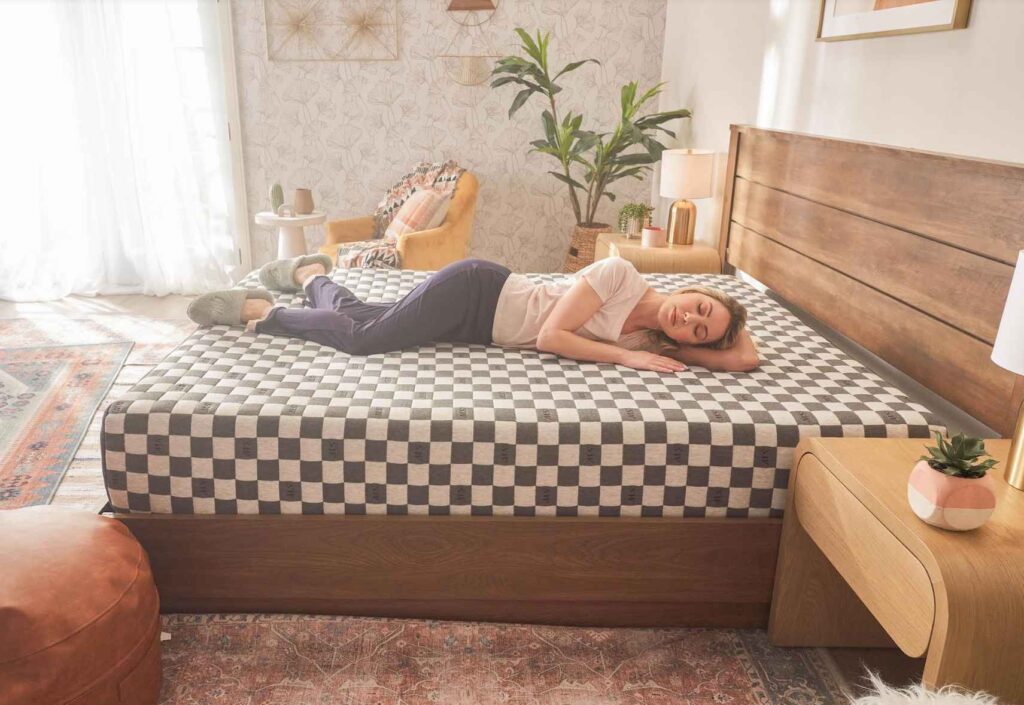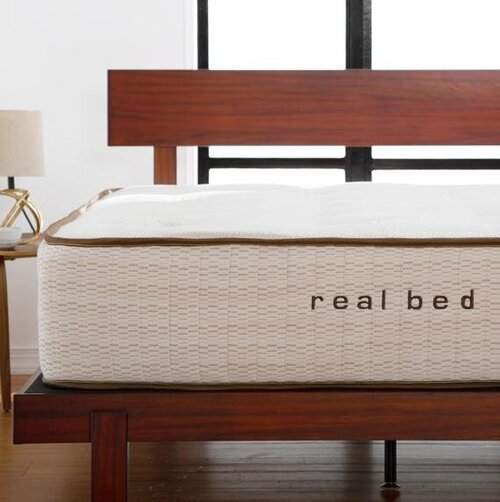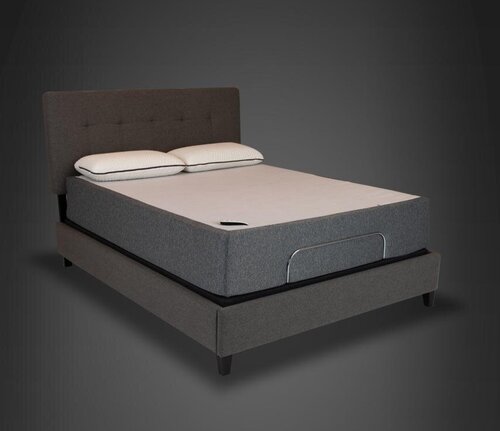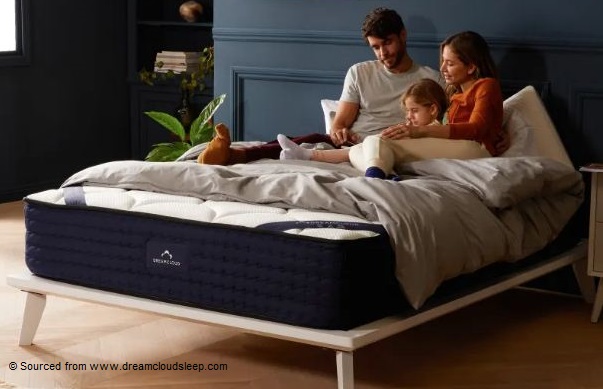The 9 Best Mattresses For Back Pain 2024, According To A 25 Year Mattress Industry Pro
The best mattress for back pain, according to experts, is soft enough to relieve pressure and pain, but supportive enough to allow you to change positions without feeling like you have to dig your way out. I designed and manufactured mattresses for 25 years, using memory foam, coils, latex, and other ingredients.
According to the Georgetown University Health Policy Institute, almost 65 million Americans have said they’ve experienced an episode of back pain. The statistics are, well, painful. Globally, around 540 million people suffer from back pain at any moment, and about 50% of employed Americans (around 80 million workers) have reported back pain in the last year.
Back pain is the sixth most costly medical condition in the USA, with direct and indirect health care costs totaling $12 billion per year. So, a lot of people are searching for a mattress that can help relieve back pain- at least while their bodies are at rest.

It’s no wonder that the driving force behind many Americans shopping for a new mattress is the quest to relieve back pain. And, mattress manufacturers have put a lot of time and energy into creating a “recipe” that can treat the symptoms. What exactly causes back pain in the first place?
Back pain can be caused by various factors, including issues with both nerves and muscles. Here are some common causes of back pain related to nerves and muscles:
- Nerve-related causes:
- Herniated or bulging discs: When the gel-like center of a spinal disc protrudes and presses on a nearby nerve root, it can cause pain, numbness, or tingling sensations.
- Sciatica: Compression or irritation of the sciatic nerve, which runs from the lower back down through the legs, can cause sharp, shooting pain that radiates down the leg.
- Spinal stenosis: Narrowing of the spinal canal can put pressure on the nerves, resulting in back pain, leg pain, and other symptoms.
- Pinched nerves: Nerves in the spine can be compressed or pinched by structures like bone spurs, leading to localized or radiating pain.
- Muscle-related causes:
- Muscle strain: Overstretching or tearing of muscles or ligaments in the back, often due to sudden movements or lifting heavy objects, can result in muscle spasms and back pain.
- Muscle imbalances: Weak or tight muscles in the back can create imbalances that cause strain and pain. For example, weak abdominal muscles may lead to increased stress on the lower back.
- Myofascial pain syndrome: Trigger points or “knots” in the muscles can cause referred pain in the back and other areas of the body.
It’s important to note that back pain can have multiple contributing factors, including trauma, illnesses, or other causes, and it’s not always straightforward to pinpoint a single cause. In many cases, there may be a variety of factors, including both nerve and muscle involvement.
If you’re experiencing persistent or severe back pain, especially if it is severe and came out of nowhere, check with your health practitioner as it could also be a sign of cardiac problems or even aortic dissection, which can be fatal very quickly.
The best mattresses for back pain tend to reduce pressure, move body weight to the sides of a mattress rather than down, and provide support that keeps your spine as straight as possible. To sum it up, the “cake recipe” requires a lot of experience to get right.
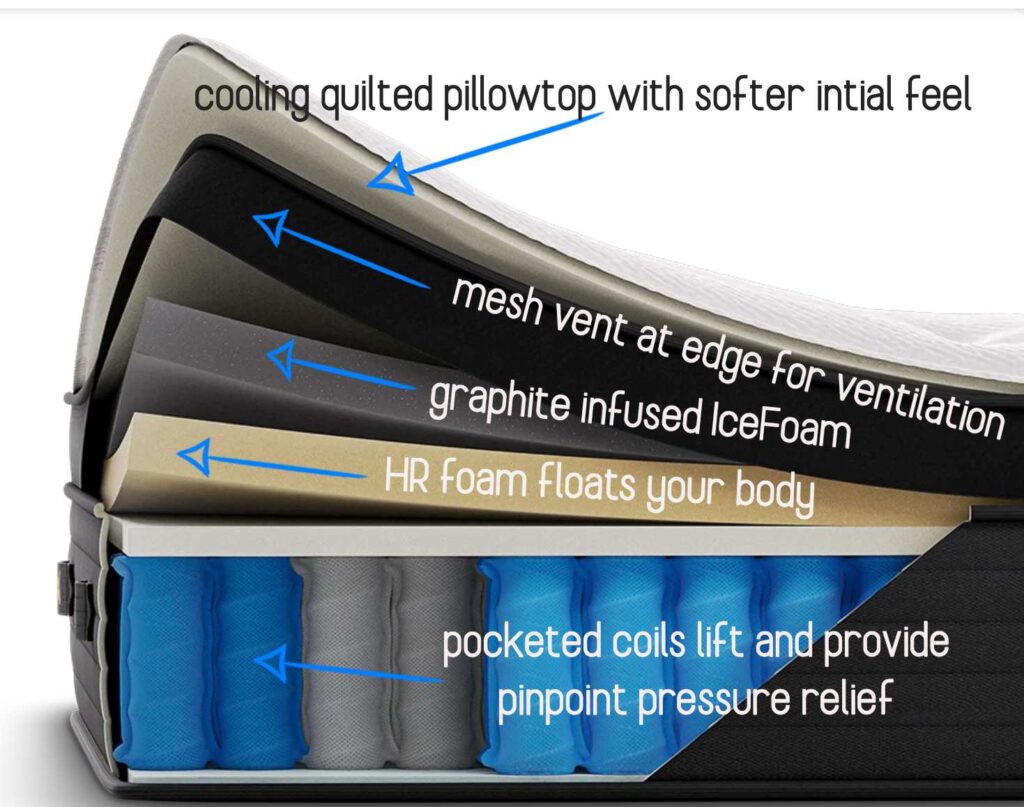
A mattress designed to relieve back pain usually requires some specialized materials that are positioned in strategic layers, much like a cake recipe, with softer layers up top and firmer layers below.
Many people with back pain are told by their doctors or healthcare providers that firmer mattresses are better, but I’m skeptical of this, after designing many custom made mattresses for people who literally can’t get out of bed because of their back pain.
Typically, they get better relief and improve their sleep and restfulness upon waking when they sleep on a mattress that is softer and more body contouring, rather than a sleep surface that is too hard.
There are many different kinds of back pain, and one mattress won’t work for all of them. To find the best mattress for back pain, let’s discuss the symptoms and causes of back pain before we zero in on specific mattress recommendations.
Generally, I will say that the mattresses I recommend will typically have either memory foam, gel foam, or natural latex as the primary “comfort” layer that you will be in immediate contact with. Under those layers will be one or two layers of transitional high density foam, and is some cases, a separate pocketed coil core.

In several cases, especially for those who prefer a pillow top section that is more immersive and body contouring, additional layers of quilted materials will be near the top of the mattress.
In cases where you toss and turn a lot, the finished surface of a mattress designed to relieve back pain will be constructed as a smooth top mattress.
This kind of mattress is easy to turn on and involves little effort so that you don’t wake up easily in the middle of the night.
Symptoms of Back Pain
Back pain can range from local pain in a specific spot to generalized pain spreading all over the back. Sometimes the pain radiates away from the back to other areas of your body, such as the buttocks, legs, or abdomen. The intensity of back pain varies for each person. Depending on the type, causes, and location of your back pain, you may experience:
- Increasing pain with lifting and bending.
- Worsening pain when resting, sitting, or standing.
- Back pain that comes and goes.
- Stiffness in the morning when awakening and lessened back pain with activity.
- Pain that radiates away from the back into the buttocks, leg, or hip.
- Numbness or weakness in your legs or feet.
You should see a doctor if your pain does not improve after a few weeks or if any of the following symptoms happen with your back pain:
- Numbness and tingling.
- Severe back pain that does not improve with medication (see Treatment section).
- Back pain after a fall or injury.
- Back pain along with:
- Trouble urinating.
- Weakness, pain, or numbness in your legs.
- Fever.
- Weight loss that you did not intend.
Causes of Back Pain
Back pain can be caused by many different factors, which may all be present at the same time and interact to result in chronic low back pain. These could include mechanical or structural problems with the spine, inflammatory conditions, and other medical problems. It is also possible that no specific cause can be identified for the start of back pain. Finding the best mattress for back pain can help reduce chronic back pain during the day.
Mechanical/Structural Problems
Back pain can happen when mechanical or structural problems develop in the spine, discs, muscles, ligaments, or tendons in the back, or compress a nerve.
- Sprain: an injury to the ligaments that support thes pine (which connect the different bones together), often occurring from twisting or lifting improperly.
- Strain: an injury to a muscle or tendon.
- Degenerative disc disease: aging causes the discs between the vertebrae of the spine to break down. It is associated with other degenerative changes in the spine, such as arthritis or spinal stenosis.
- Herniated or ruptured discs: an event causing a disc to compress and irritate nearby nerves. This often occurs at the lumbar level but can be present in the cervical spine as well.
- Spondylolisthesis: a vertebra in the spine slips out of place or gradually moves out of alignment.
- Spinal stenosis: a narrowing of the spinal canal that puts pressure on the spinal cord and nerves.
- Fractured vertebrae.
- Scoliosis or other congenital changes to the spine.
- Myofascial pain: tightness and pain of the muscles supporting the spine due to damage to the muscles or a result of the nerve input to the muscles coming from the spine.
Inflammatory Conditions
- Ankylosing spondylitis, a specific type of arthritis of the spine.
- Other types of inflammatory arthritis of the spine.
Other Medical Conditions
- Osteoporosis, which can lead to painful fractures of the vertebrae.
- Fibromyalgia, a condition of widespread muscle pain and fatigue.
- Kidney stones or infections.
- Endometriosis, which is the buildup of uterine tissue in places outside the uterus.
- Infections that involve the bones of the spine or the discs between these bones, which can cause back pain.
- Tumors, in rare cases, that develop on the spine or other areas of the back.
- Pregnancy.

Living with back pain requires that we invest time trying to find a mattress that provides sufficient relief so we can rest comfortably and get the restorative rest needed to heal and restore. Hopefully, our choices below can give you the support, comfort, and pressure and pain relief you need.
My Top 9 Choices For Mattresses For Back Pain Might Surprise You.
THE PUFFY ORIGINAL MATTRESS: EFFECTIVE PRESSURE RELIEF
Carefully balanced with “CloudFoam”, a more responsive memory and gel foam mixture, I found this mattress to have more “float” factor and better body contouring than similarly priced models.
At $1049 in queen, it’s fairly priced, and is outfitted with 10″ of combined comfort and support layers.
I like the fact that Puffy uses safer, low VOC, and formaldehyde free Certi-Pur foam. Resists packing down and compression. Read my enhanced review here if you want more details.
Excellent for chronic back pain, but is softer than many foam mattresses. Google reviews: 4.9 Rating out of 5, from a total of 6,572 Online Reviews. Garners best in class verifiable reviews from its owners. My #1 pick for chronic pain because of 4lb. density proprietary cooling Cloud foam.
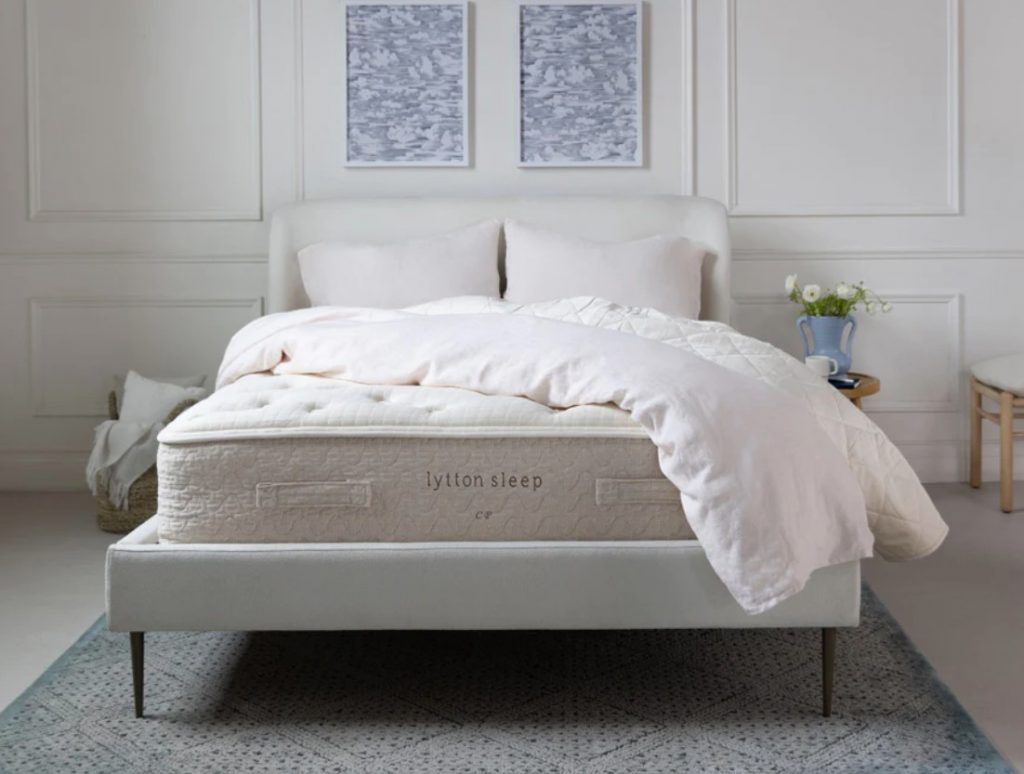
LYTTON SIGNATURE MATTRESS
This hand tufted premium memory foam and pocket coil hybrid is available in two levels of firmness, a plusher and firmer model.
Both are made with a breathable, cooling gel/memory foam that sleeps cool and contours your body with a subtle hug sensation.
At $1899 in queen, it’s a tad pricier than other hybrid/foam/pillow top models, but it was excellent for my lower back and shoulder pain.
Very comparable to resort hotel mattresses with thicker pillow top section, and because of the pocket coil core, edge support was notably better than average.
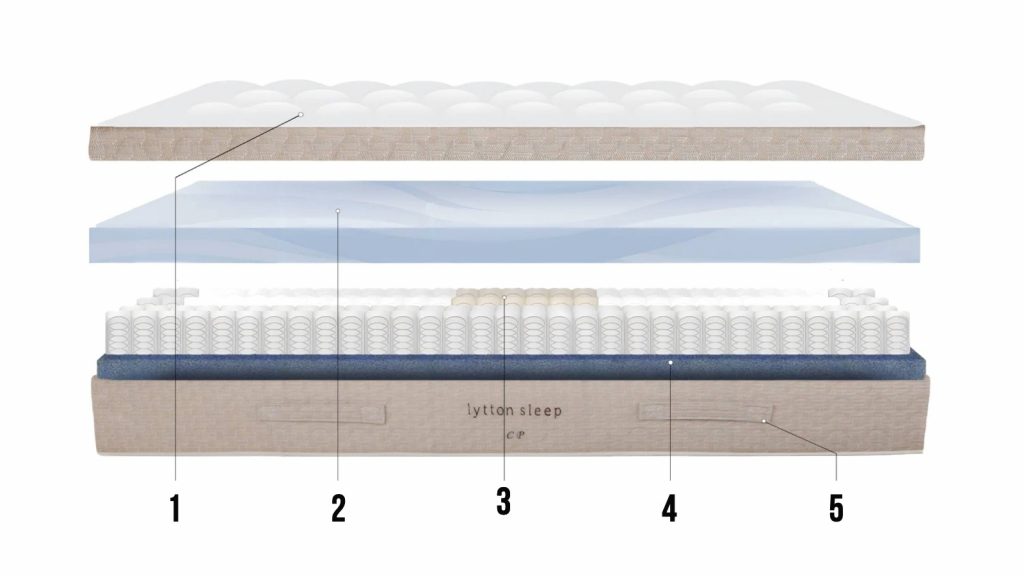
With thicker, beefier comfort layers and its plush, overstuffed top, I loved its creamy, panda’s belly feel. Get a 100 night trial and solid 15 year warranty.
NOLAH ORIGINAL MATTRESS
Soft and sumptuous, and built for side and side/back sleepers, The Nolah Original Mattress is made with safer non toxic foams, including a specialized material called cooling AirFoam™.
For pain, targeted pressure relief melts pinpoint pain away. I test drove this mattress for two weeks and it dramatically improved my spine pain, caused by scoliosis and years of weight lifting.
It’s scientifically proven to provide 4x better pressure relief on hips, shoulders, and back. Also, the company donates proceeds various wildlife management organizations. A good way to give back and get the pain relief you deserve.
THE AWARA MATTRESS: LEVITATE YOURSELF
This outstanding natural latex hybrid bed is loaded with clean, chemical free ingredients. You’ll nest upon a breathable organic quilted top, and beneath you, your body floats on 4” of botanical Dunlop latex.
Individually pocketed coils suspend and hover you, relieving lower back pain and pain between shoulders. Delivered with 365 day no questions asked trial and FOREVER warranty!
Thickest layer of pure latex rubber on the market helps melt pain away. Click here if you want to learn more about natural latex and why it is so beneficial for back pain.
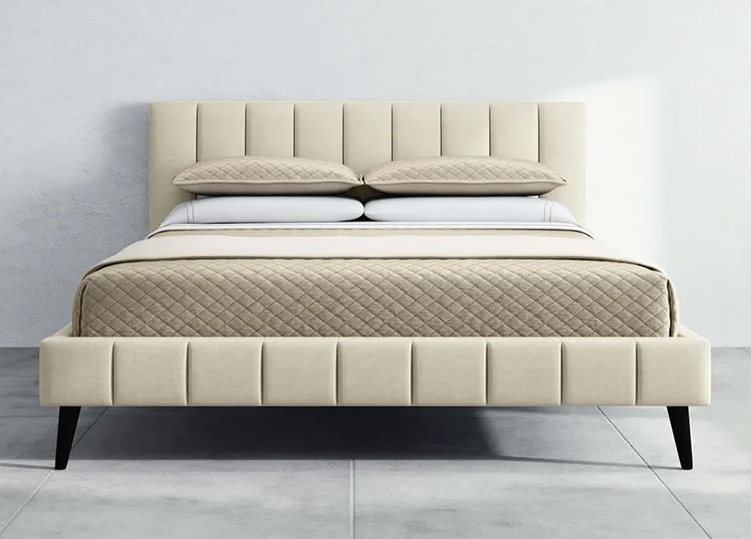
SAATVA MEMORY FOAM HYBRID MATTRESS
By using a higher density memory foam than typical bed in a box brands, this medium firm cooling memory foam and pocket coil hybrid provided fast onset pressure and pain relief within minutes.
While on my side, I didn’t feel like I had to dig my way out of the middle and the edge support is ideal for sitting, and for leg danglers too.
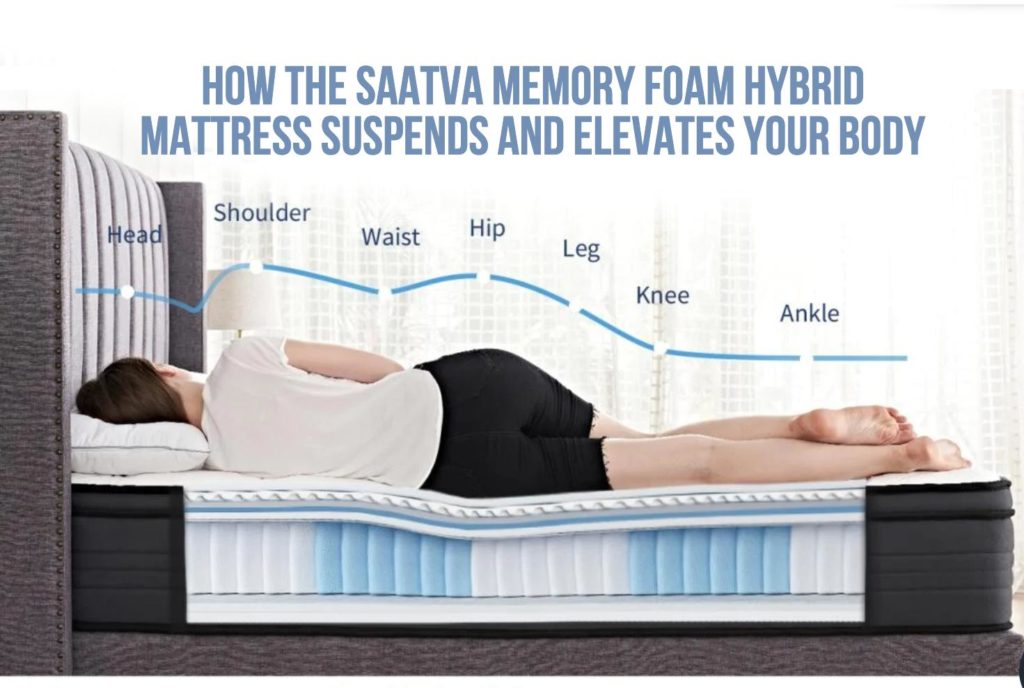
I give this Saatva option top marks for buoyant, supportive, and lively feel with out a “dead” sensation I find on lots of memory foam options.
$1495 in queen, and you get free in home setup and old mattress removal too. Lifetime warranty, 365 day no questions asked trial.

HABITAT ASCEND DIGITAL AIRBED
Habitat Furnishings offers the best digital sleep number style airbed on the market. Half the price of sleep number beds. The bed is made with both natural latex and premium memory foam, the best recipe you can get for back pain.
You control your own level of firmness or softness on either side- excellent for managing back pain and severe pressure that varies from day to day.
Built-in sumptuous pillow top. LED wireless remote controls with memory setting. Sale offers $1200 off everyday prices. 90 Day Free Trial, solid warranty, made in USA! Best bed for couples, allowing for individual settings on each side.
SWEETNIGHT PRIME MATTRESS
This flippable, all foam mattress is essentially two mattresses in one. At under $950 in queen size, you can choose from a softer feel or a firmer, more supportive side.
You can go to my enhanced review page and learn a lot more about this innovative mattress option. I actually kept my sample and use it as my guest room mattress and sleep on it with my cat, JB!
When I get shoulder pain flare-ups, I like the softer side to relieve inflammation and pain.
THE REAL BED – SUPERNATURAL COMFORT FOR COUPLES
An outstanding natural mattress that delivers supernatural comfort and pain relief. An organic outer quilted cover, a layer of eucalyptus infused rayon that cools, organic wool, 3” of pure botanical latex all floating above a pocketed coil system that evenly supports your body.
No chemicals, and kept my spine so level that my lower back pain disappeared after about an hour on my side or back. Compare at $1800 and up. Queen just $950. Proven “cake recipe” of latex and pocketed coil layer.
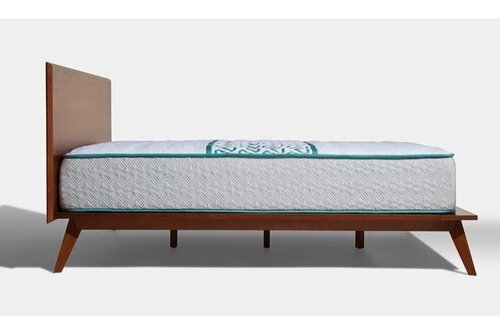
DIAMOND “GRATEFUL” MATTRESS
Looking for great support, especially at hips and shoulders? Our team loves this unique coil and foam hybrid. Gel memory foam on top, a pocketed coil system below with zoned support for torso and hips. A unique feature: a foam edge which provides perimeter support for sitting and increases usable space on the mattress. Queen size $999, 120 Night Trial. A+ marks.
5G AND EMF SHIELDING MATTRESS: THE ANTI-AGING BED®
Hybrid mattress featuring EMF and 5G radiation shielding system. FDA backed technology using static and charge removal surface. Detox, remove free radicals, and get restorative and recharged rest. The true “bio-hack anti-aging mattress”.
The company even offers solid research that demonstrates how their technology can reduce pain and inflammation.
Ground your body, relieve back pain. Owners swear by it. FDA proven to enhance recovery for injuries, increase general wellness, temporary increase in local blood flow and promotes a restful night of sleep.
THE DREAMCLOUD PREMIER HYBRID MATTRESS
Described as a soft, breathable sanctuary, the Dreamcloud delivers on back pain relief. Nice buildup with sumptuous cashmere quilted top, floating pocketed coils, and a quality 4lb. density layer of gel infused memory foam.
Owners report excellent support with no bottoming out. Great for neck and shoulder pain too. Minimal motion transfer and soft on shoulders and hips, it’s just $1199 in queen. I LOVE this option for chronic lower back pain, and hip pain as well.
With my link, get $399 worth of free gifts included in your purchase, plus 365 night trial period, Lifetime Warranty. Just $999 in queen size.
Finding a mattress that promotes wellness and encourages healing is a critical step in managing back pain
We’ve tested and reviewed dozens of mattresses designed to provide relief and considered the following data points when analyzing outcomes for users with different comfort preferences. We considered:
- Pressure relieving ability within 5 minutes of lying on mattress on side, back, and belly.
- Ability to support weight up to 235 lbs without resulting in compression more than 3″ on side
- Ability for mattress to fill in pocketed areas in lumbar area and between shoulder blades
- Cooling ability which influences sleep induction (falling asleep) and level of deep sleep
- Ability for mattress to properly support couples under 400 lbs. combined in middle of mattress
- Textiles used in outer coverings that do not bunch, wrinkle, or gather when being slept on
Everyone’s personal experience with back pain is unique, and there are many kinds of back pain, and a broad range of medical treatments for the condition, but choosing the right mattress is likely the most important decision you will make to ultimately provide the relief you deserve.
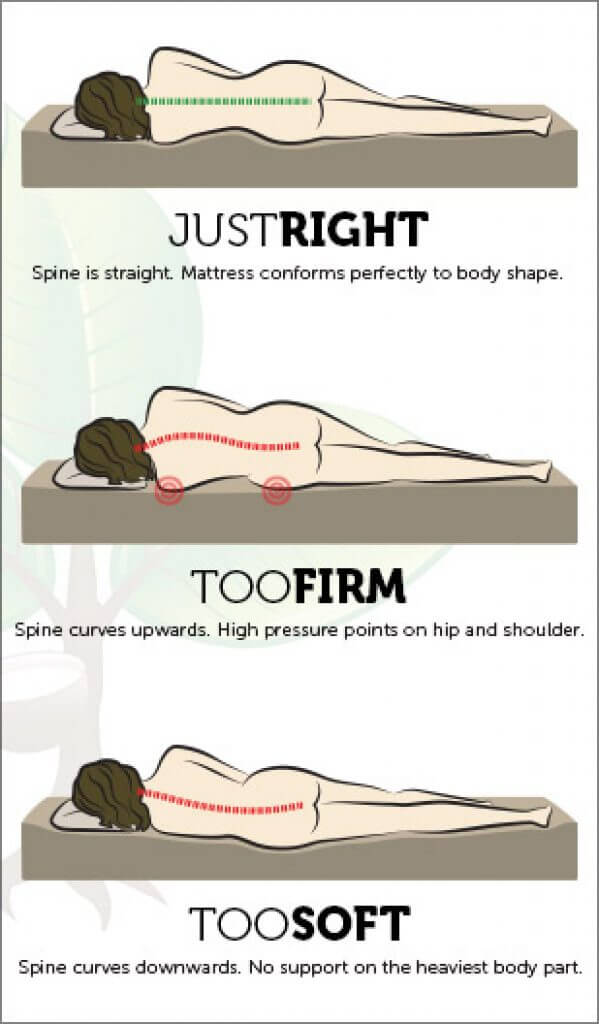
You may have no idea where to start to find a mattress that will reduce your pain and inflammation. The most important thing to remember is that regardless of your body type, weight, age, or general medical condition, a mattress for back pain should offer several key features.
It should provide proper spine alignment, effective weight distribution, and have enough softness and buoyancy to be able to reduce downward pressure points that can actually make back pain worse.
We all need to typically spend 7-9 hours on our mattresses a night to get the restorative rest we need, however, many people with severe back pain will stay in bed for far longer.
A well designed mattress for back pain relief should relieve pressure, promote vascular circulation to reduce inflammation, and distribute weight equally across the plane of your body.
As you may already know through personal experience, back pain can be uniquely complex and difficult to diagnose and treat. There are many types of back pain, and a wide range of treatments that may or may not work for the same condition.
Trying to sort between hundreds of mattress options, especially when you are dealing with pain, can be frustrating and stressful.
I’ve eliminated about 90% of the options out there and filtered out a small handful of proven mattresses that owners themselves describe as being productive and providing genuine relief.
In most cases, these mattress options cradle your hips and shoulders and fill in void areas like between ribs and hips when on your side, and in between shoulder blades and at the lumbar area when you are sleeping on your back.
Although many mattress review sites recommend manufacturers and brands that proclaim guaranteed pain and pressure relief, there really is no mattress that is custom designed to fit each and every body. However, there are essential designs that promote back pain relief because they use certain materials like pocketed coils, latex, gel and memory foam, and even textiles like cashmere and wool.
First, let’s discuss what causes back pain and also figure out why a mattress is essential in the process of calming and reducing inflammation and promoting restorative, uninterrupted sleep. You can also find even more information about back pain on our Chiropractor page, and find out which mattresses they recommend for back pain relief.
The intensity and manageability of back pain is completely different for every person. For example, one person with a herniated disc may experience excruciating pain while another person with the same condition has no symptoms at all. Similarly, a muscle strain can range from infrequent and occasional severe, to mildly annoying.
In any case, pressure relieving materials like memory foam and latex can help distribute weight to the sides and away from the body rather than straight down, which can create railroad spike points of pain. Many traditional firmer innerspring mattresses can actually create pain rather than help to diminish it.
With some conditions, back pain can flare up and then subside, only to flare up again after a few weeks or months and gradually intensify over time. Knowing which kind of mattress to invest in for the long term is like adding another layer of treatment options to back pain issues.
Many structures in your back can cause pain
Your back is subjected to many surprisingly strong forces throughout the day, such as from twisting, sudden jolts, or poor posture when sitting hunched over. Any of your spines many interconnected and overlapping muscles and connective tissues are capable of becoming injured and producing back pain. Common anatomical causes of back pain include:
- Large muscles that support the spine
- Spinal nerves that exit the spinal canal and may go to the legs or elsewhere
- Facet joints that connect the vertebrae along the back of the spine
- Intervertebral discs that provide shock-absorption for the bones
For more information, see Spinal Anatomy and Back Pain. Bones, ligaments, tendons, and other anatomic structures are also capable of causing back pain. Also, see Causes of Lower Back Pain.
Types of back pain: The underlying cause may be hard to identify
It is usually difficult for the brain to distinguish between injury to one spinal structure versus another nearby. For example, a torn or herniated disc may feel similar to an arthritic facet joint due to their close proximity. In some cases, the same nerve root can be compressed or irritated by different structures, such as a disc or bone spur.
Your physician will take a thorough medical history, discuss your symptoms, and conduct a physical exam in order to accurately diagnose the cause of back pain. Sometimes diagnostic tests—such as X-rays, MRI scans, or diagnostic injections—are needed when trying to locate or confirm the underlying cause of pain.
In fact, physicians can often be a surprisingly great resource for figuring out what kind of mattress you need to relieve back pain.
How you describe your pain, its area of distribution, and any related symptoms are important to determine a back pain diagnosis. Three common classifications of back pain include:
- Axial pain. Also called mechanical pain, axial pain is confined to one spot or region. It may be described a number of ways, such as sharp or dull, comes and goes, constant, or throbbing. A muscle strain is a common cause of axial back pain as are facet joints and annular tears in discs.See Axial Back Pain: Most Common Low Back Pain
- Referred pain. Often characterized as dull and achy, referred pain tends to move around and vary in intensity. As an example in the lower back, degenerative disc disease may cause referred pain to the hips and posterior thighs.See Low Back Pain with Referred Pain
- Radicular pain. Commonly described as electric shock-like or searing, radicular pain follows the path of the spinal nerve as it exits the spinal canal. This type of pain is caused by compression and/or inflammation to a spinal nerve root. In the lower back (lumbar spine), radicular pain may travel into the leg.
- Sciatica. Other terms for radicular pain are sciatica or radiculopathy (when accompanied by weakness and/or numbness). It can be caused by conditions such as a herniated disc, spinal stenosis, or spondylolisthesis.See Radiculopathy, Radiculitis and Radicular Pain
Back Pain Is Very Real, Even If No Anatomical Reason Is Found
Even after many tests and doctor visits, in a small percentage of patients the anatomical cause for your back pain may remain elusive. If this is the case, the pain still needs to be treated and there are a variety of nonsurgical care options that can help alleviate or manage the pain.
Psychological factors, such as depression and sleeplessness, can make the pain worse and also need to be included as part of a comprehensive treatment program.
See Chronic Pain and Insomnia: Breaking the Cycle
For persistent back pain and/or any neurological symptoms, it is always important to see a qualified spine specialist for a diagnosis. Ultimately, participating in the decision-making process about your medical care may help you have a better outcome. Understanding your pain is an important element of this process.
I’m Marc Anderson, and I’ve been in the mattress industry for 25 years, both in the brick and mortar retail side as well as online with my own e-commerce web sites. I’ve been the CEO of several companies that have designed and manufactured mattresses created exclusively to relieve back pain.
One of the most commonly asked questions by customers, of all ages, is which kind of mattress is best for both chronic back pain and occasional pain issues?
There are a lot of mattresses to choose from online that, at first glance, may seem be a good fit, but very few mattresses, especially if they are made with primarily foam layers, that will relieve back pain.
The key is to find a mattress with what we call the right “cake recipe”, that is the perfect combination of layers, including the kind of materials, the density and thickness of those layers, and even the kind of fabric that is used for the outer covering, as this influences the flexibility of the underlying materials and just how much back pain relief you will experience.
As an expert in the different kinds of materials that make up the “cake recipes” of a mattress designed to relieve back pain, I am extremely familiar with components, including polyurethane and urethane foams, natural latex and soy based foams, coils large and small, air chambers for sleep number style beds, and exterior fabrics and quilting for the finished top, which is referred to as the “body contact” part of a mattress. But is there a magic recipe for the perfect bed that helps ease back pain all across the board? Well…yes and no.
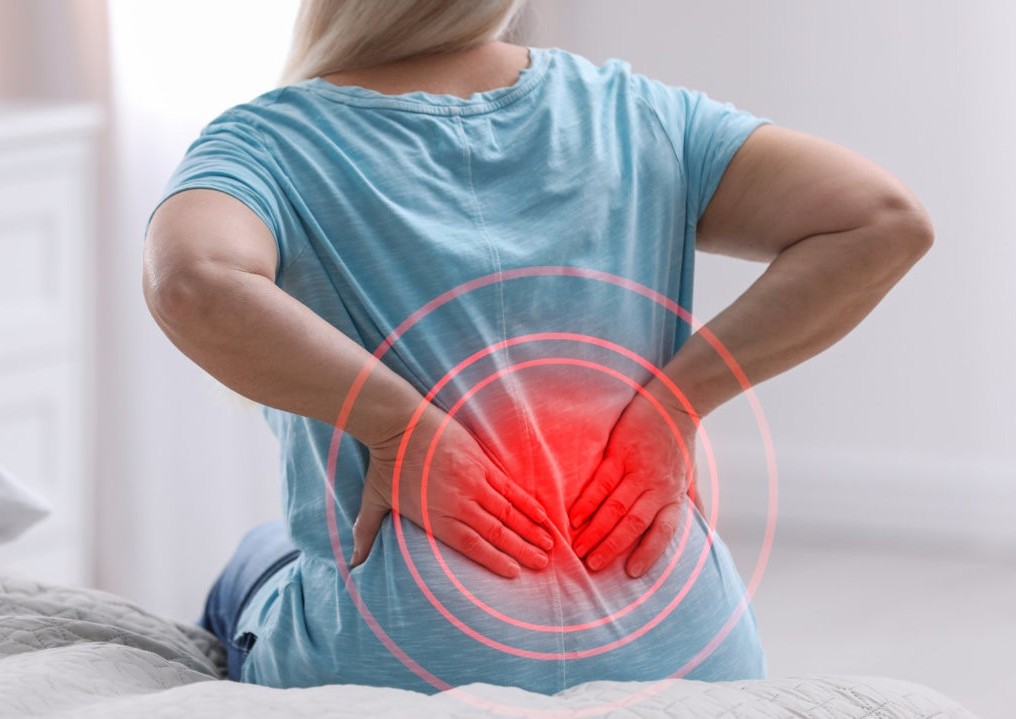
I can give you advice on beds to steer clear of, and suggest materials that really should be incorporated into a mattress designed for therapeutic application for back issues. One thing to remember is that humans are unique and very individualized creatures.
We are all shaped differently, our musculature and connective tissues are not aligned exactly the same, our vertebral columns responds to stimuli differently, we perceive pain very differently, and there is no one perfect solution, but there ARE key ingredients that should be considered in the “cake recipe” of your ideal bed.
One common ingredient that the best mattresses for back pain all have in common, in most cases, is memory foam. Another ingredient that offers back pain relief, but is an all natural product and has a more lively sensation to it, is natural latex.
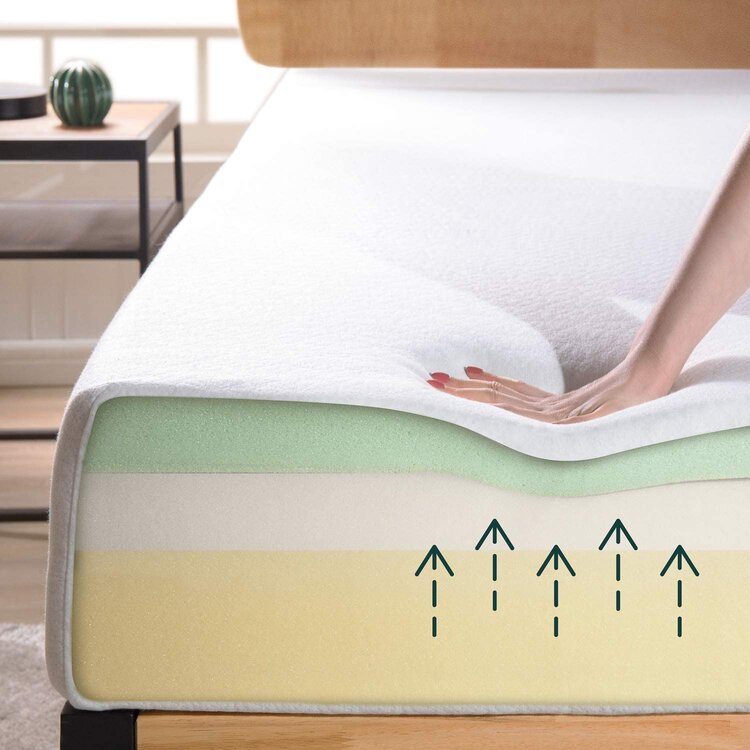
These two components are critical essentials to a mattress that is targeted at back pain sufferers. The simple reason is that these two ingredients distribute weight laterally, or sideways, rather than down, and help ease pain by eliminating pressure points.
If you have chronic back pain as the result of trauma or surgery, which many of our readers struggle with, buying a quality mattress that relieves pressure by redistributing your weight across the entire surface of your mattress should be precisely what you are seeking.
Not to worry, as we have researched a curated selection of a handful of mattress choices that deliver on the pressure relief that you will need.
the cake recipe for a mattress designed to relieve back pain: eliminate pressure and increase comfort and support
The most significant and effective relief from back pain in a mattress, in my experience, can be obtained from a combination of memory foam, latex, and a firmer and supportive base or foundation layer at the bottom, if you choose to buy a bed in a box type mattress online, as an example.
A coil or innerspring mattress is a good choice too, but you get better results with a layer of latex and memory immediately in combination with one another, sandwiched together, on top of the coil layers. I’m going to unravel all of this in a moment, with some bullet points, to make it easier.
I once had a customer call me who had been bitten by a tick and contracted Lyme’s Disease. The woman was only 30 years old, was essentially bed ridden, and had horrible back pain. She truly suffered, could not work, and her pain was so awful that she cried herself to sleep.
At the time, we did not custom make mattresses and we sold a standard lineup. I stepped out of my comfort zone and designed her a mattress, from scratch. She had it for a week before she called to tell me that she finally, FINALLY, slept through the night. I was thrilled, and she was able to enjoy resting her head on a mattress that relieved her pressure.
Surprisingly, the mattress was surprisingly simplistic: it contained a fairly dense bottom layer of polyurethane foam, about 6” thick, and immediately above it I incorporated a 2” layer of natural latex, and above that a 2” layer of specialized memory foam which was a little more dense that the kind of memory foam used in most mattresses sold online in the “bed in a box” category.
The outer cover was kept fairly thin, not overly quilted (the woman slept hot), and was made using a bamboo fabric that felt smooth, uplifting, and cloud-like.
For severe back pain, associated with herniated discs, as well as neurological issues such as sciatica, and shoulder and hip injuries, I recommend a mattress that has a fairly supportive base, really as firm as you can tolerate, but with memory foam and gel foam on top. Memory foam and gel foam are specialized materials, first invented by NASA, to distribute weight laterally, spreading the impact and the weight, rather than in pinpoint fashion in a downward direction.
This characteristic alone, taking advantage of materials that spread weight sideways, as if you are spreading pizza dough to the edge of a pan, is crucial in creating as close to a “zero gravity” effect as possible to distribute load. Also, these materials generally do not sleep hot, despite what you read, largely due to cooling technology being built into the outer covering of most mattresses these days.
Memory foam actually has a “false reputation” for sleeping hot, but after 20 years working very closely with the material, I have to totally disagree, and as far as I am concerned, it is a miracle ingredient.
Natural latex is highly beneficial for back pain too, though I like it better in lower back and hip pain applications. Being botanically derived, too, is a good thing, especially when there are allergies and sensitivity to petroleum based chemicals involved. My Lyme Disease customer had an aversion to anything fragrant, and the latex we used for her really helped with that.
Natural latex is highly responsive, whereas memory foam is doughy and wraps around your body, cradling it. Latex is spongy and very “fast”, and you tend to float above it a bit more than memory foam. Each material has wonderful qualities, and it is when you combine them that you really squeeze the benefits out of each and exponentially increase their benefits.
Take a look at all of the models we offer below. Truly, I feel that all of them are good choices for back pain sufferers, but let’s give specifics for choosing each one based on your back pain type and situation.
I’ve put together a selection of beds that I believe are helpful. Here’s the list below with links. I’ve matched up each selection with a specific recommendation.
How To Choose The Best Mattress For Back Pain: Enhanced Information
The best mattress for back pain has to perform two important functions. One of them is to relieve pressure, and the other is to offer support so that muscles in the body don’t have to work during rest.
A poorly designed mattress will often not the ability to move pressure away from the body, but rather, create pinpoint pressure spots that cause pain and soreness. Typically an all foam mattress uses both memory foam, a kind of foam that has a yielding, “melting in” kind of sensation.
It’s very similar to pizza dough when pressed to the outside of the pan. It pushes weight away, kind of like a wave in the water when you strike it. Underneath a memory foam layer, a really talented mattress designer might build in some natural latex, which has a springy, buoyant sensation, which keeps your body suspended.
These two foam combinations, when placed close to each other, are ideal for pressure relief and to prevent bucketing, which creates a trapped sensation, and makes it difficult to dig your way out of the mattress, turn, or even to site comfortably on the edge.
One of the problems with foam mattresses is that they have to be calibrated perfectly to not only accommodate weight without sinking into the middle, but also must be soft enough to be comfortable at areas like hips and shoulders to help relieve back pain.
For back pain, I often recommend shopping for a mattress that has at least 2” of memory foam, 2” of latex or a similar very flexible open celled foam that is all at once squishy, springy and has some stretch to it as well.
The reason for this is that you want a mattress to be able to respond to your body as it turns, twists, and moves during the night. It also helps if the outer fabric material, called the ticking or exterior fabric, is also stretchy, breathable, and has a little bit of quilt to it.
Many of the mattresses I recommend above incorporate stretchier fabrics that might also have some natural fibers in them as well, like bamboo, hemp, or organic cotton. These help to make the mattress cooler, which also aids in reducing inflammation and back pain.
The best mattresses for back pain may also have a layer of coils strategically placed below the top “comfort layers” of foam, but above the bottom layer. These coils are usually what is called “pocketed coils” meaning a system of up to 1,200 coils which operate independently from one another.
The coils act much like a suspension in an automobile, gently cradling and absorbing weight and movement, and keeping your body floating above the bottom layer of the mattress which is typically a very dense layer of high density foam.
For back pain, a pocketed coil system, generally as part of what is called a “hybrid mattress” is useful when your body weight is higher than normal, and for couples who tend to cuddle in the middle of their mattress.
In an all foam mattress, where there are no pocketed coils, the layer of denser supportive foam is often 6-8” thick to allow for proper support without creating depressions or dipping.
A well designed mattress can drastically improve back pain and allow your body to get restorative rest that heals and allows tissues to regenerate.
Can A Mattress Be Designed To Relieve Back Pain?
After spending 25 years as a mattress inventor and designer, I can tell you that the best mattresses for back pain have had a lot of thought put into them. And, there are very specific kinds of materials that have to be properly calibrated in the right thicknesses and levels of firmness to work.
Memory foam, for example, is commonly heralded as the best single component of a mattress that will help with back pain. Further, there have been studies that have investigated the effectiveness of memory foam mattresses for reducing back pain. Here are some examples:
- A study published in the Journal of Chiropractic Medicine found that patients with chronic low back pain who slept on a medium-firm memory foam mattress reported a significant reduction in pain and stiffness compared to those who slept on a firm mattress. From my own experience, though, I’ve found that lower back pain can be improved with a softer memory foam with a denser underlying polyurethane foam component. This is actually how many of the big selling memory foam mattresses sold online are made.
- A study published in the Journal of Manipulative and Physiological Therapeutics compared a group of patients with chronic low back pain who slept on a memory foam mattress to a control group who slept on their usual mattress. The study found that the group who slept on the memory foam mattress reported a significant reduction in pain and improved sleep quality.
- A study published in the Journal of Musculoskeletal Pain found that participants who slept on a memory foam mattress for 28 days reported a significant reduction in low back pain compared to those who slept on a standard hospital mattress.
The reason why memory foam has been proven to be effective is because it has properties that allow it to push weight away to the side rather than downward. This eliminates pinpoint pressure. Imagine if you are spreading pizza dough to the sides of a pan rather than taking your thumb and pressing down on it in one spot.
It’s important to note that the effectiveness of memory foam mattresses for reducing back pain may depend on individual factors such as the severity and cause of the pain, as well as personal preferences for mattress firmness and sleep position.
Why A Softer Mattress Made With Memory Foam Or Natural Latex Might Be Better For Back Pain
For years I’ve insisted that anyone with back pain would be better off sleeping on a softer rather than firmer mattress option. The best mattresses for back pain offer body contouring and allow your body to relax while you sleep. Firmer mattresses tend to cause stiffening and tightening of the muscles, releasing lactic acid which can be painful and actually increase pain while you sleep. Here’s why a softer mattress, overall, can provide benefit for back pain:
- Pressure Relief: Memory foam and latex mattresses have the ability to contour to the body’s shape and distribute weight evenly. This helps to alleviate pressure points and reduce the strain on sensitive areas such as the hips, shoulders, and lower back. By providing better pressure relief, a softer mattress can help minimize discomfort and pain.
- Spinal Alignment: A softer mattress can conform to the natural curves of the body, including the spine. This helps to maintain proper alignment, allowing the spine to rest in a more neutral position during sleep. By supporting the natural curvature of the spine, a softer mattress can help reduce strain on the back and alleviate back pain.
- Absorption Of Movement: Memory foam and latex have the ability to absorb and isolate movement. This means that when you move or shift positions during sleep, the mattress will minimize the transfer of motion to your partner. This can be particularly beneficial for individuals with back pain who may need to change positions frequently to find a comfortable sleeping posture.
- Enhanced comfort: A softer mattress can offer a greater level of comfort, allowing you to sink into the surface slightly. This can help relieve muscle tension and promote a more relaxed and restful sleep. Improved comfort can be especially important for individuals with back pain, as it allows for better relaxation and reduces the likelihood of waking up feeling stiff or sore. The best mattresses for back pain should be inviting and something you look forward to at bedtime.
